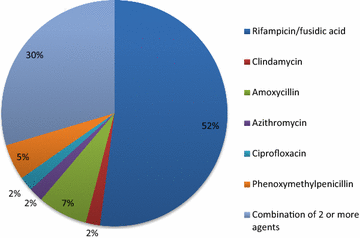Surveillance of life-long antibiotics: a review of antibiotic prescribing practices in an Australian Healthcare Network
- PMID: 28100229
- PMCID: PMC5241934
- DOI: 10.1186/s12941-017-0180-6
Surveillance of life-long antibiotics: a review of antibiotic prescribing practices in an Australian Healthcare Network
Abstract
Background: The rise of antimicrobial use in the twentieth century has significantly reduced morbidity due to infection, however it has also brought with it the rise of increasing resistance. Some patients are on prolonged, if not "life-long" course of antibiotics. The reasons for this are varied, and include non-infectious indications. We aimed to study the characteristics of this potential source of antibiotic resistance, by exploring the antibiotic dispensing practices and describing the population of patients on long-term antibiotic therapy.
Methods: A retrospective cross-sectional study of antibiotic dispensing records was performed at a large university hospital-based healthcare network in Melbourne, Australia. Outpatient prescriptions were extracted from the hospital pharmacy database over a 6 month period in 2014. Medical records of these patients were reviewed to determine the indication for prescription, including microbiology, the intended duration, and the prescribing unit. A descriptive analysis was performed on this data.
Results: 66,127 dispensing episodes were reviewed. 202 patients were found to have been prescribed 1 or more antibiotics with an intended duration of 1 year or longer. 69/202 (34%) of these patients were prescribed prolonged antibiotics for primary prophylaxis in the setting of immunosuppression. 43/202 (21%) patients were prescribed long-term suppressive antibiotics for infections of thought incurable (e.g. vascular graft infections), and 34/43 (79%) were prescribed by Infectious Diseases doctors. 66/202 (33%) patients with cystic fibrosis were prescribed prolonged courses of macrolides or fluoroquinolones, by respiratory physicians. There was great heterogeneity noted in indications for prolonged antibiotic courses, as well as antibiotic agents utilised.
Conclusion: Our study found that that continuous antibiotic therapy represented only a small proportion of overall antibiotic prescribing at our health network. Prolonged courses of antibiotics were used mainly to suppress infections thought incurable, but also as primary and secondary prophylaxis and as anti-inflammatory agents. More research is needed to understand the impact of long-term antibiotic consumption on both patients and microbial ecology.
Keywords: Antibiotics; Infection; Pharmacy; Resistance; Suppression.
Figures
Similar articles
-
Characterisation of antibiotic prescriptions for acute respiratory tract infections in Danish general practice: a retrospective registry based cohort study.NPJ Prim Care Respir Med. 2017 May 19;27(1):37. doi: 10.1038/s41533-017-0037-7. NPJ Prim Care Respir Med. 2017. PMID: 28526836 Free PMC article.
-
Assessment of prescribing practices at the primary healthcare facilities in Botswana with an emphasis on antibiotics: Findings and implications.Int J Clin Pract. 2017 Dec;71(12). doi: 10.1111/ijcp.13042. Epub 2017 Nov 27. Int J Clin Pract. 2017. PMID: 29178350
-
Why has antibiotic prescribing for respiratory illness declined in primary care? A longitudinal study using the General Practice Research Database.J Public Health (Oxf). 2004 Sep;26(3):268-74. doi: 10.1093/pubmed/fdh160. J Public Health (Oxf). 2004. PMID: 15454595
-
Inventory of antibiotic stewardship programs in general practice in France and abroad.Med Mal Infect. 2015 Apr;45(4):111-23. doi: 10.1016/j.medmal.2015.01.011. Epub 2015 Mar 5. Med Mal Infect. 2015. PMID: 25747501 Review.
-
[Antibiotic therapy in Bielefeld (AnTiB)-a local project for the promotion of rational antibiotic prescribing in the outpatient pediatric sector].Bundesgesundheitsblatt Gesundheitsforschung Gesundheitsschutz. 2019 Aug;62(8):952-959. doi: 10.1007/s00103-019-02978-y. Bundesgesundheitsblatt Gesundheitsforschung Gesundheitsschutz. 2019. PMID: 31209503 Review. German.
Cited by
-
Antimicrobial Resistance in the Context of the Sustainable Development Goals: A Brief Review.Eur J Investig Health Psychol Educ. 2021 Jan 19;11(1):71-82. doi: 10.3390/ejihpe11010006. Eur J Investig Health Psychol Educ. 2021. PMID: 34542450 Free PMC article.
-
PET/CT Imaging for Personalized Management of Infectious Diseases.J Pers Med. 2021 Feb 16;11(2):133. doi: 10.3390/jpm11020133. J Pers Med. 2021. PMID: 33669375 Free PMC article. Review.
-
Oral Staphylococcus Species and MRSA Strains in Patients with Orofacial Clefts Undergoing Surgical Rehabilitation Diagnosed by MALDI-TOF MS.Pathogens. 2024 Sep 5;13(9):763. doi: 10.3390/pathogens13090763. Pathogens. 2024. PMID: 39338954 Free PMC article.
-
Management of Refractory Post-operative Osteomyelitis and Discitis: A Case Report.Cureus. 2024 Jan 20;16(1):e52620. doi: 10.7759/cureus.52620. eCollection 2024 Jan. Cureus. 2024. PMID: 38374846 Free PMC article.
-
The distribution of antibiotic use and its association with antibiotic resistance.Elife. 2018 Dec 18;7:e39435. doi: 10.7554/eLife.39435. Elife. 2018. PMID: 30560781 Free PMC article.
References
-
- Dawson MH, Hobby GL, Meyer K. Penicillin as a chemotherapeutic agent. Ann Intern Med. 1943;19(5):707–717. doi: 10.7326/0003-4819-19-5-707. - DOI
-
- Smith MT, Zurynski Y, Lester-Smith D, Elliott E, Carapetis J. Rheumatic fever—identification, management and secondary prevention. Aust Fam Physician. 2011;41(1–2):31–35. - PubMed
MeSH terms
Substances
LinkOut - more resources
Full Text Sources
Other Literature Sources
Medical


